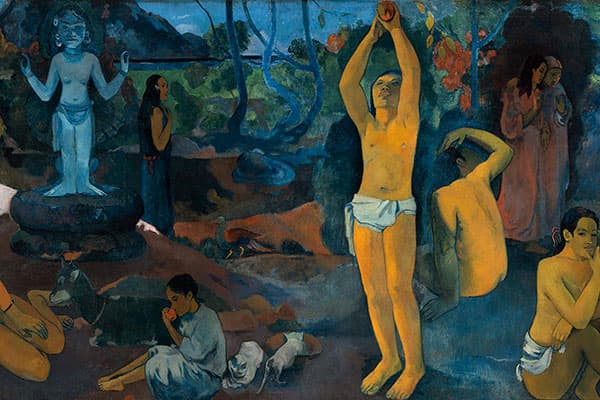Paul Gauguin in the Tropics
by G. Fernández – theartwolf.com
In the spring of 1891, an elegant and comfortable ship called Océanien was crossing the Indian Ocean en route to the French colonies in New Caledonia. Its picturesque passengers, divided into three classes under the deck, included wealthy, important functionaries and landowners; and young people of humble origins who traveled to the colonies searching a future they did not find in the old France. In other words, the transoceanic ship was sort of a human zoo, a circus with so many actors that nobody noticed the presence of a middle age man with a large moustache, who spent the endless hours sitting on the deck, gazing into the horizon. Nevertheless, that anonymous personage who occupied one of the humble third-class cabins was not an ordinary passenger. He was an admired painter called Paul Gauguin, who travelled to Tahiti searching an artistic redemption, a comeback to the primitive and the exotic life that could help him to find a way in which his Art would be purified. In his own words, “The West is rotten (…) and anyone who feel like Hercules could find new strengths travelling to far-away places. And then come back one or two years later, strengthened”
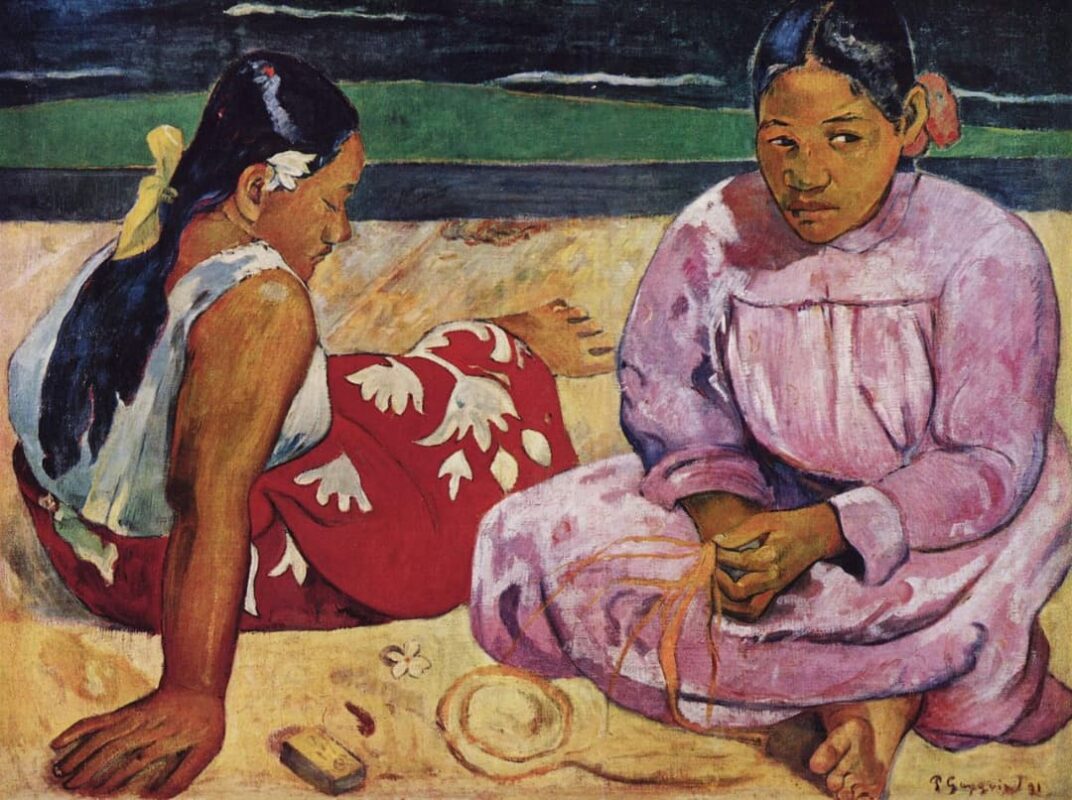
The life and works of Paul Gauguin in Tahiti and the Marquises
Nevertheless, Gauguin’s trip was not exactly a “poor man’s odyssey”. In fact, he asked the French ambassador to personally welcome him at Papeete ‘s harbour, as an official guest of the French Government. In addition, Papeete -the Tahitian capital- was not the tropical paradise that it could have been decades before, the exotic and mysterious town described by great travellers like the legendary Captain Cook. No, Gauguin soon realized that such paradise had been “killed” after many years of civilian, military and religious colonization. However, he could still find -in rural areas far enough from the capital- an important part of the “exotic” and “primitive” culture Gauguin was searching.
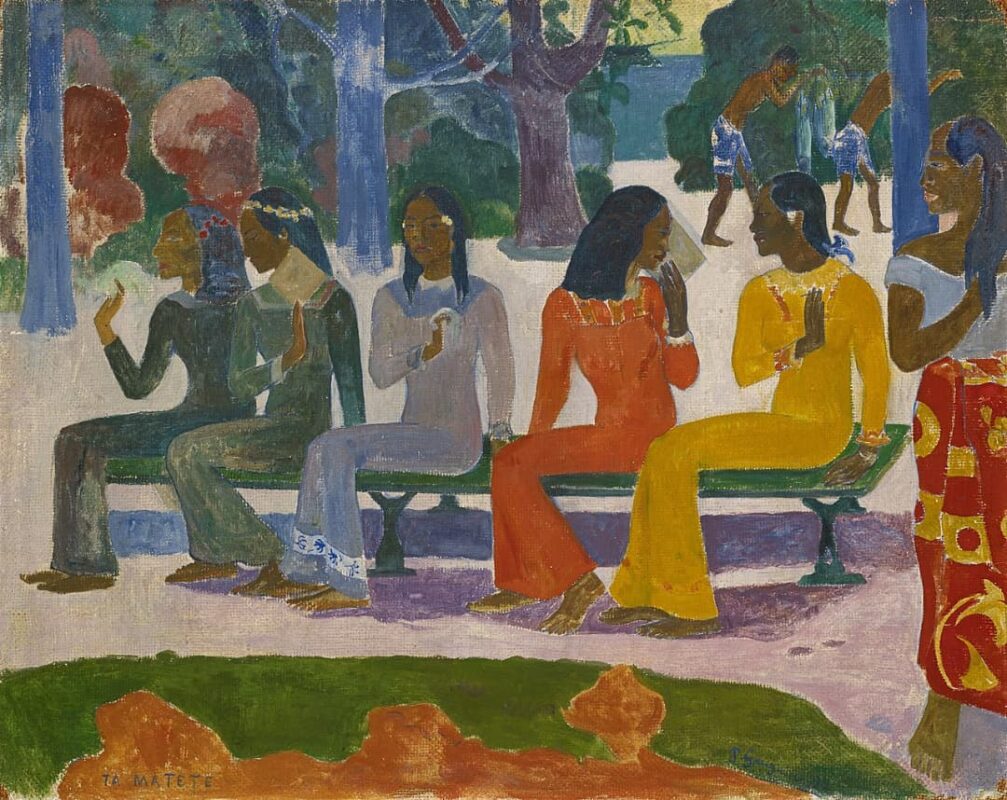
WAS GAUGUIN A COLONIZER?
In the last decades, some art critics and historians have criticized Gauguin’s paternalistic attitude during his first years in Tahiti (when he described Polynesians as “meek” and even “fool“), comparing him to the first colonizers, who aggressively tried to impose the laws and faith of the Old Continent.
In “Ia Orana Maria (Salve, Maria)” (New York, Metropolitan Museum ), a work painted during his first year in Tahiti, Gauguin transferred the Catholic iconography into the exotic South Pacific. The Madonna, the child, and even the two women in adoration and the golden-winged angel in the background, are clearly Polynesian natives. Here Gauguin introduced the Catholic Faith into the local culture, making the natives the protagonists of this typically Western religious scene. Nevertheless, this painting, its composition being quite different from those of the European tradition (to the point of that we can not determine with certainty if it is an “Annunciation” or an “Adoration”) is followed by many works in which the local tradition of the natives is the protagonist, like in “Manao tupapau” (“The spirit of the dead watches you”, Buffalo, Albright-Knox Art Gallery), considered by Gauguin himself as one of the masterworks of his first Tahitian period. The artist described the painting with these words: “This people have a traditional fear to the spirit of dead people (…) I have represented the apparition as a simple little woman because the girl (…) can only see it as a person that she met, a person like herself”.
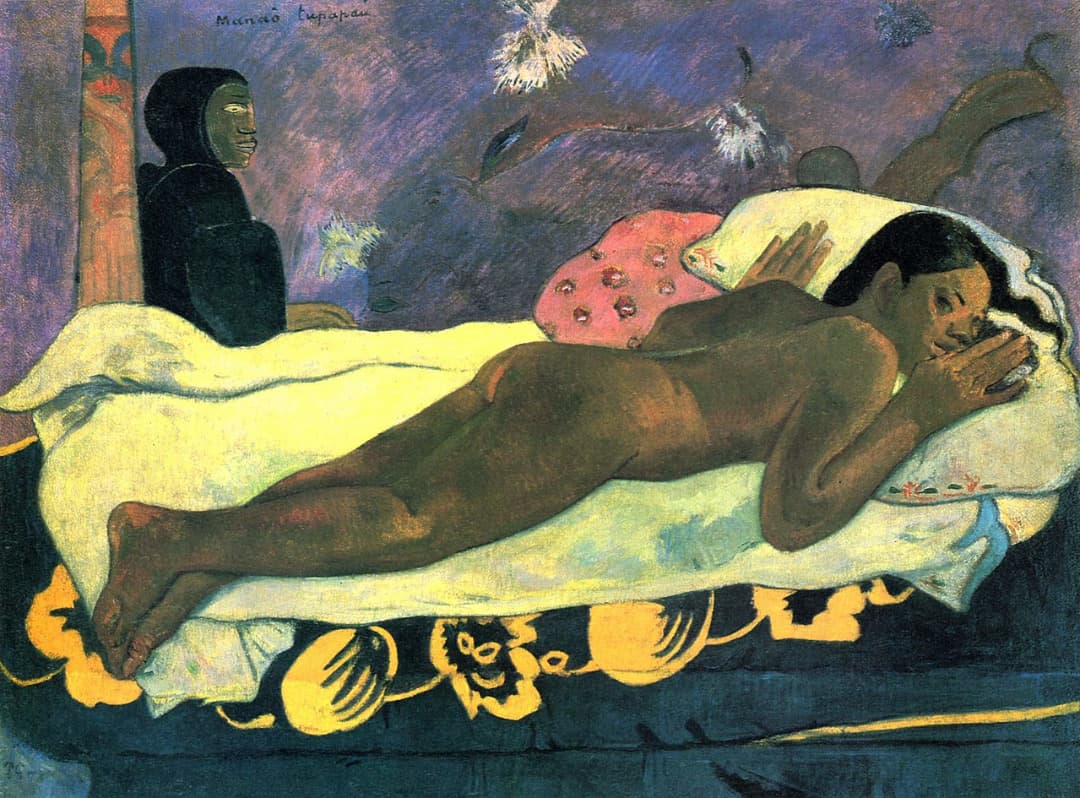
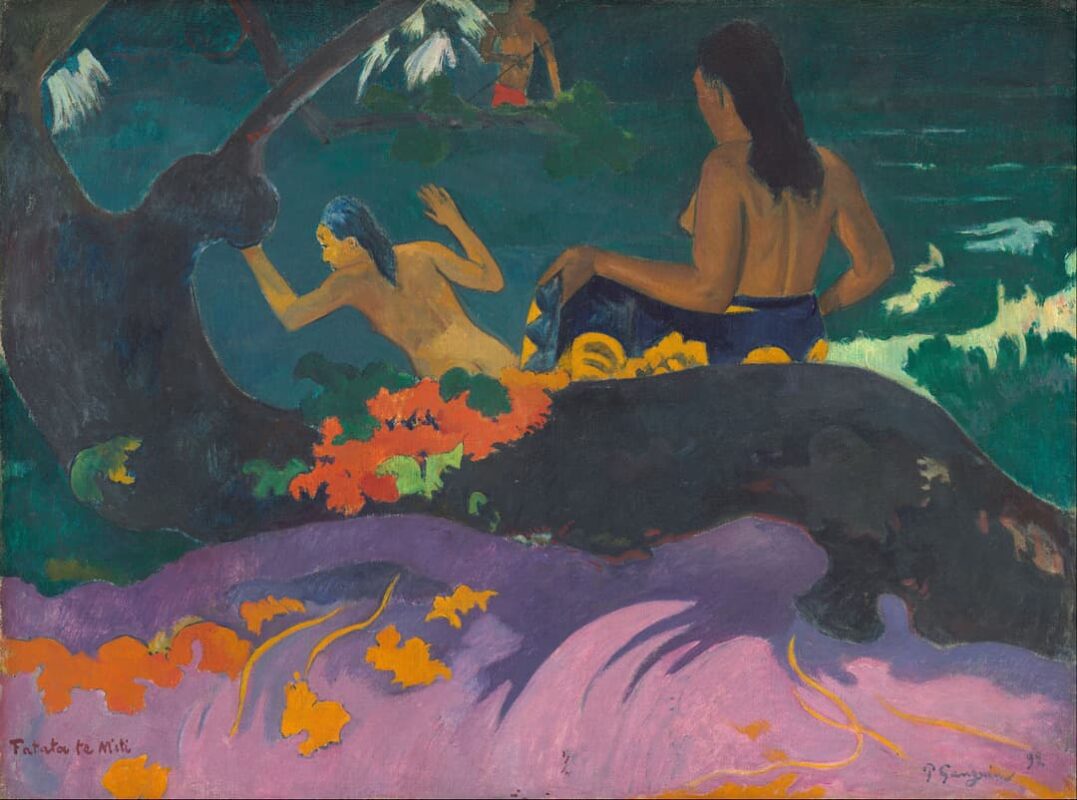
With this painting, Gauguin progressively abandoned the Catholic iconography and began introducing himself into the native tradition , although he temporary recovered the Christian themes in paintings such as “Te Tamari No Atua (The birth of Christ”) (Munich, Neue Pinakothek) or “Maternité” (two versions, one in the Ermitage and another sold in 2004 at Sotheby’s for $39.2 million). These ancestral beliefs achieved a predominant position not only in his artistic oeuvre, but also in his personality. The Catholic “colonizer” turned into a ferocious detractor of the Catholic Church, while in his interior he began to accept the local native beliefs, as we can see in “The white horse” (Paris, Museé de Orsay), or in the supreme “Matamua – in olden times-“ from the Thyssen collection, which depicts a legendary valley in the middle of the island, in which its inhabitants “still live as in past times”; or in the many statuettes of Gods and idols that he made in the following years.
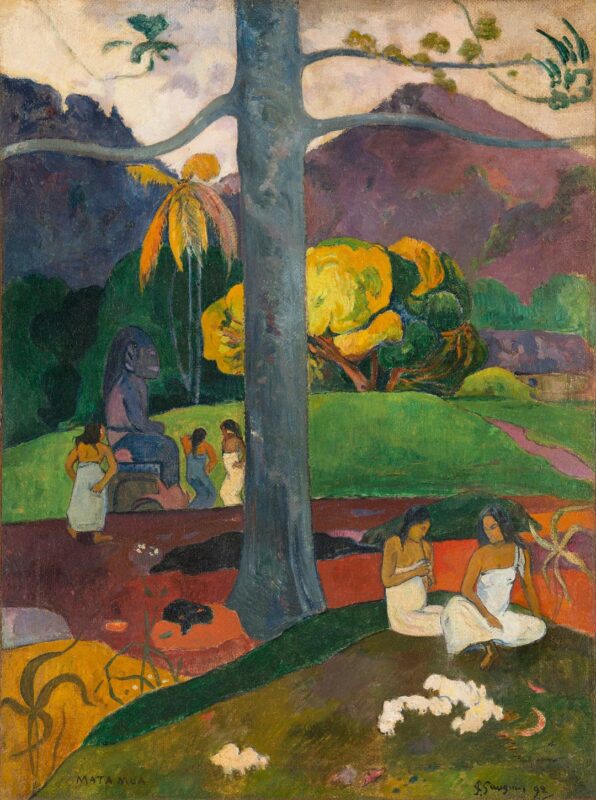
IDOLS AND GODS
In the last years of his life in the Marquises, Gauguin wrote about the Polynesian sculpture tradition: “This Art has disappeared because of the missionaries, who considered those sculpture (…) fetishism, an offence to God”. He was right. In fact, at the end of the 19th century, almost all the ancient Polynesian wood sculptures had been destroyed by the devastating Christian missions. Gauguin embarked on an epic work: returning the natives to their destroyed mythology.
Unfortunately, almost all the sculptures Gauguin created in Tahiti were carved in low-quality wood, which caused its premature destruction. Nevertheless, the Orsay Museum in Paris conserves two little statuettes of this creative period: the “Idol of the shell” and the “Idol of the pearl”. The date of both sculptures, although inexact, can be situated around 1892. In both figures Gauguin has represented the Polynesian god Taaroa, whose shell contains -according to the Polynesian tradition- the entire universe. But it was in 1894, back in Paris (we will talk about this comeback in the next chapter) when Gauguin created his undisclosed masterpiece in sculpture: the statuette of “Oviri” (Paris, Orsay Museum), a sinister representation of the Polynesian God of the death and the mourning. The figure, which Gauguin called La Tueuse (The killer) is a disturbing female figure of primitive and crude gestures, long hair and huge eyes, which stands over the terrific figure of a dead wolf.
But this iconographic recuperation that Gauguin began is not only visible in the three-dimensional works: in the following years, the artist transferred this “recovered” iconography to his paintings, where he found more possibilities: in the canvas, the gods and idols could change its scale, turning into the main protagonists of the scene (“The day of the gods”, 1894); or in spirits as disturbing apparitions (“Riders in the beach”, 1902)
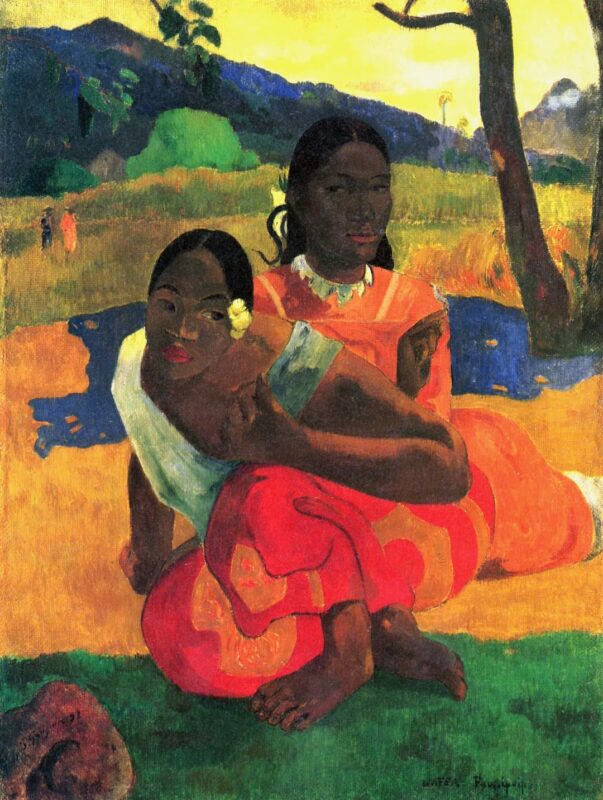
THE INTERMISSION IN FRANCE
But Gauguin’s life in Tahiti was far from being paradisiacal: in addition to the heartrending solitude and his perennial economic difficulties, during the last months of 1892 Gauguin became seriously ill, losing sight and suffering constant diarrheas and coughing up of blood that forced him to be hospitalized for many months. Desperate, he wrote to the French Ministry begging him for a repatriation that took place at the end of the following year.
Back at home, and after being hospitalized in Paris in much better sanitary conditions than in the Polynesian islands, (and after receiving the inheritance of his uncle Isidore), his physical and economical situation improved. He rented an apartment in Paris and lived there with Annah the Javanese. In addition, Gauguin exhibited fifty of his works in an important exhibition of modern Art in Copenhagen. In other words, nobody could suppose that Gauguin’s adventure in the Polynesia could be repeated.
But Gauguin returned. He returned two years later, after discovering that he had contracted syphilis. He returned after a brawl in which his ankle was broken. He returned after painting in Paris a praise, a fantasy of the Tahitian culture, the masterwork entitled “Mahana no Atua (The day of the gods”) (Chicago, Art Institute), in which the goddess Hina is adored by a group of women who dance surrounded by multicolour waters. In short, he returned after realizing that his place was no longer among the European people. “What a stupid way of life, the European way of life!” On April 3rd, Gauguin left Europe, never to return again.
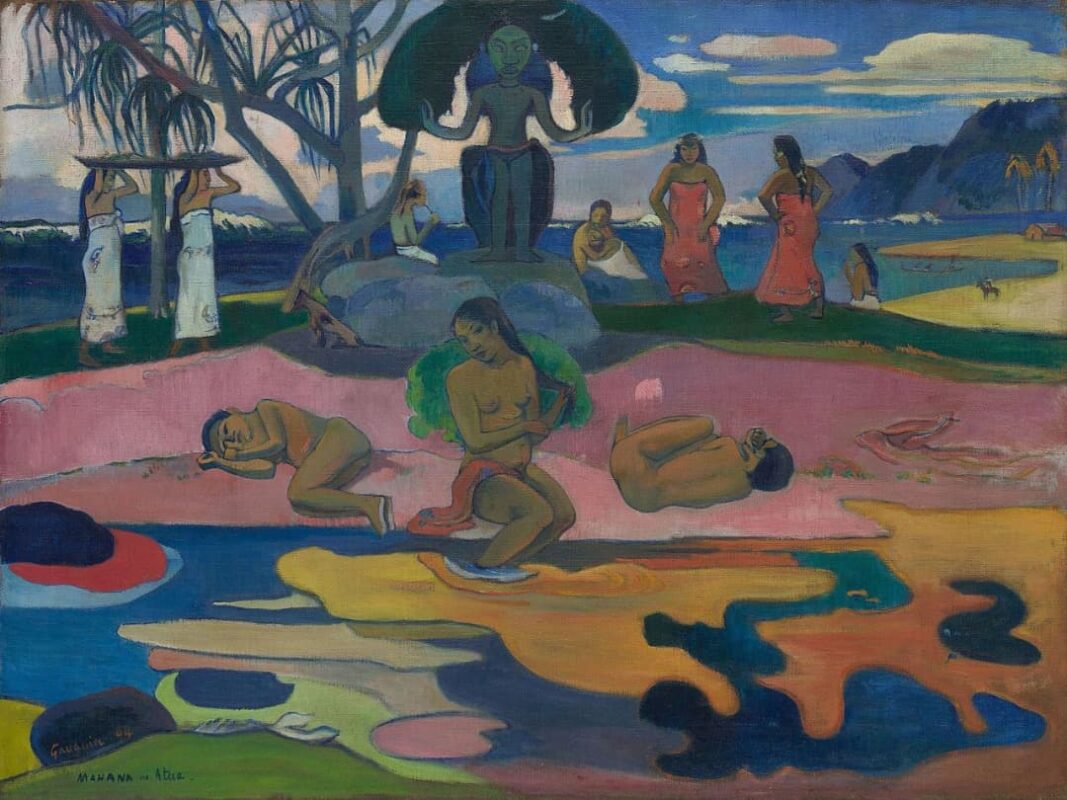
“I AM A CRIMINAL” – BACK IN TAHITI
“I want to end my life here, in the solitude of my shack. Oh yes, here I am a criminal, but… what is wrong with that? Michelangelo was also a criminal.”
Back in Tahiti, Gauguin felt liberated, free of any artistic or social corset. In his progressive separation from any vestige of the European society, he left Papeete and moved to a sack in the middle of the countryside, perhaps searching that fabulous valley he had depicted in the “Matamua”.
Free of these social conventions, Gauguin created a new “Eve” using Tahitian women as his model. The artist had never hidden his admiration for Tahitian young women, even for the too young ones (his lover Pau’ura was only 14 years old), and, during his French intermission, he boasted in front of his friends about his conquests, saying that every night several Tahitian girls jumped into his bed “as possessed by evil spirits” (an attitude that gave him a nice syphilis). The female figure is the protagonist in works like “Te arii Vahine (The queen of the beauty”) (1896, Moscow, Pushkin Museum), “Girls with mango flowers (or Two Tahitian)” (1899, New York, Metropolitan Museum.)
Another paradigmatical work of this period is the famous “Nevermore” (1897, Courtauld Institute Galleries, London), a work in which the female nude is still visible. Nevertheless, something from the old Europe is still present in the work: the painting pays tribute to the famous poem by Edgar Allan Poe, which Gauguin had listened at the Café Voltaire in Paris. However, the raven -main protagonist of Poe’s story, in which it is depicted as sinister and menacing- is in Gauguin’s canvas not as important as the strong and vibrant female nude.
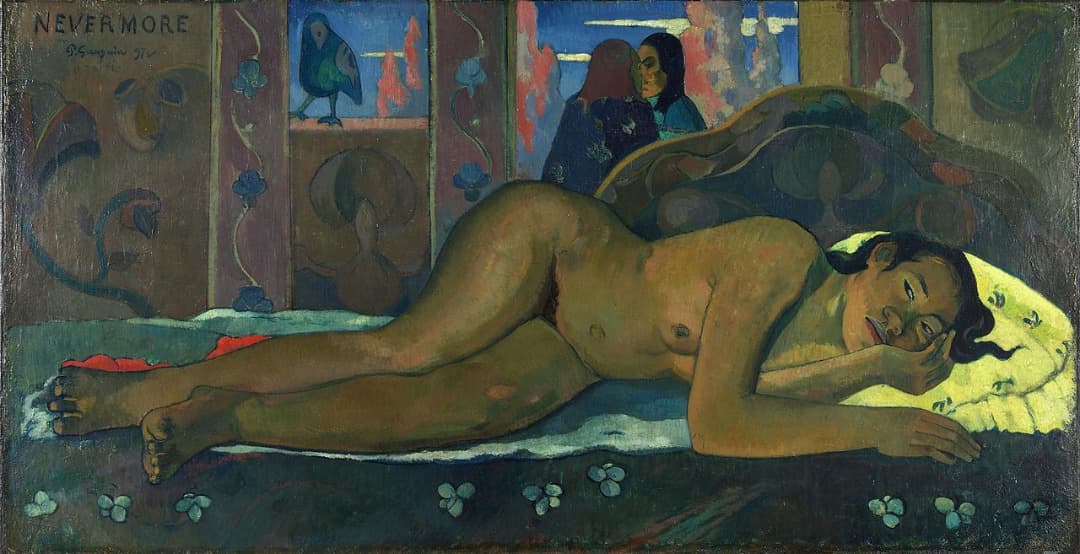
WHERE DO WE COME FROM? WHAT ARE WE? WHERE ARE WE GOING?
Paul Gauguin affirmed that after painting “Where do we come from? What are we? Where are we going” he tried to commit suicide. We do not know for certain if that confession was true or not, but it is a fact that just before painting his masterwork, a series of events followed each other in a dramatic sequence, as presaging a tragic end that would happen five years later. First, his economic situation became extremely difficult –however, he rejected an important amount of money offered by the Ministry because he considered it a “charity”- while the syphilis and the alcoholism turned his physical situation into a torture. Nevertheless, the worst hit arrived by mail: in the spring of 1891, a letter informed him of the death of his daughter Aline, age 21. This tragic event provoked not only the break-up with his wife –Gauguin irrationally accused her of Aline’s death- but also his definitive rupture with any vestige of faith. In a devastating letter wrote that year, Gauguin affirmed: “My daughter is dead. Now I don’t need God.”
In such psychical condition Gauguin embarked on the epic mission of creating his artistic testament, a work that resumes all his other creations: Where do we come from? What are we? Where are we going? is not only the most colossal canvas ever painted by Paul Gauguin, but it’s also the work that explains the entire philosophical and pictorial doctrine of the artist.
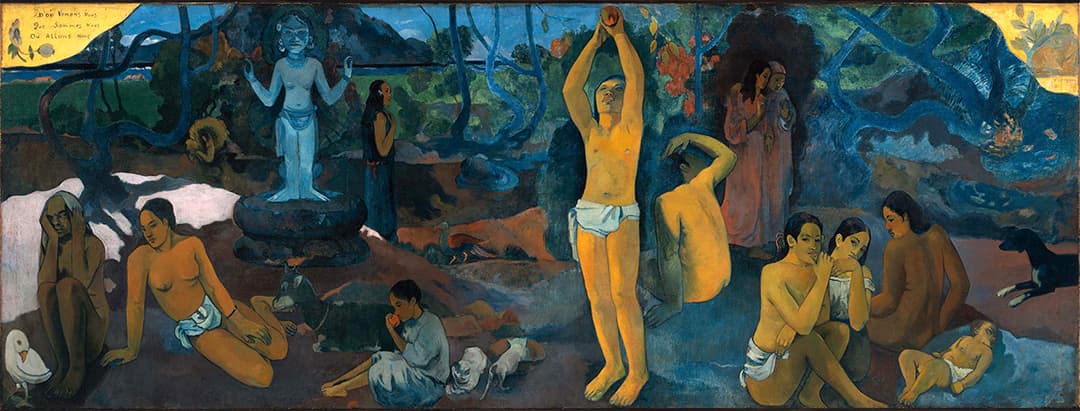
In a striking horizontal format, the canvas follows an inverted chronological order, beginning at the left corner with the heartrending figure of an ancient mummy in fetal position, her ears covered with her hands; while at the right corner, a baby, symbol of the life and the innocence, is surrounded by three Tahitian young women. At the centre of the picture, the figure of a man who takes a fruit symbolizes the temptation of the man. Structuring the canvas in an inverted chronological order, Gauguin seems to point the primitive, the innocent, as the only one way for the artist.
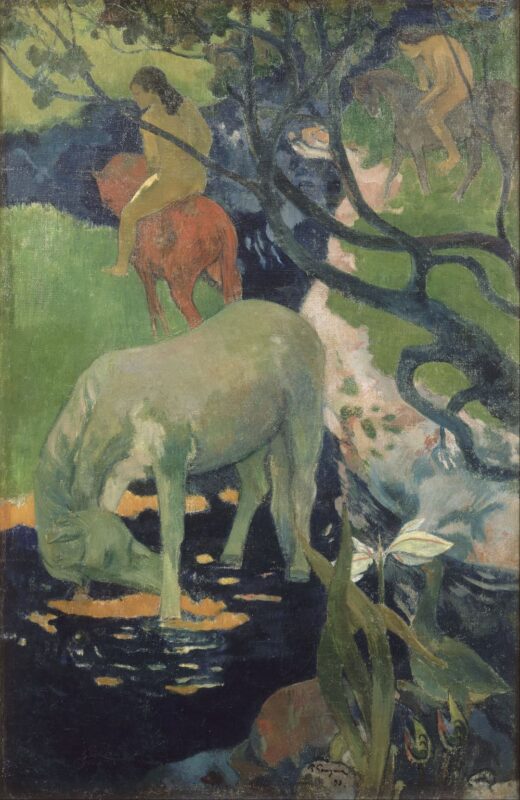
THE LAST CHORD – FLIGHT INTO THE MARQUISES
In September 1901, Gauguin left Tahiti and took up his residence in the Marquises Islands. The reason of this flight is still not clarified: while his admirers suggest that the artist was seeking a new stage to his artistic concerns, many historians have noted that his physical deterioration was so evident that his popularity among Tahitian girls was below zero, forcing him to long periods of abstinence. Anyways, Gauguin established himself in Hiva Da, the main island of the Marquises archipelago, in lands owned by the Church. Just before his trip, he painted a beautiful farewell to Tahiti in his ” Idyll in Tahiti” (1901, Zurich , E. G. Buhrle collection)
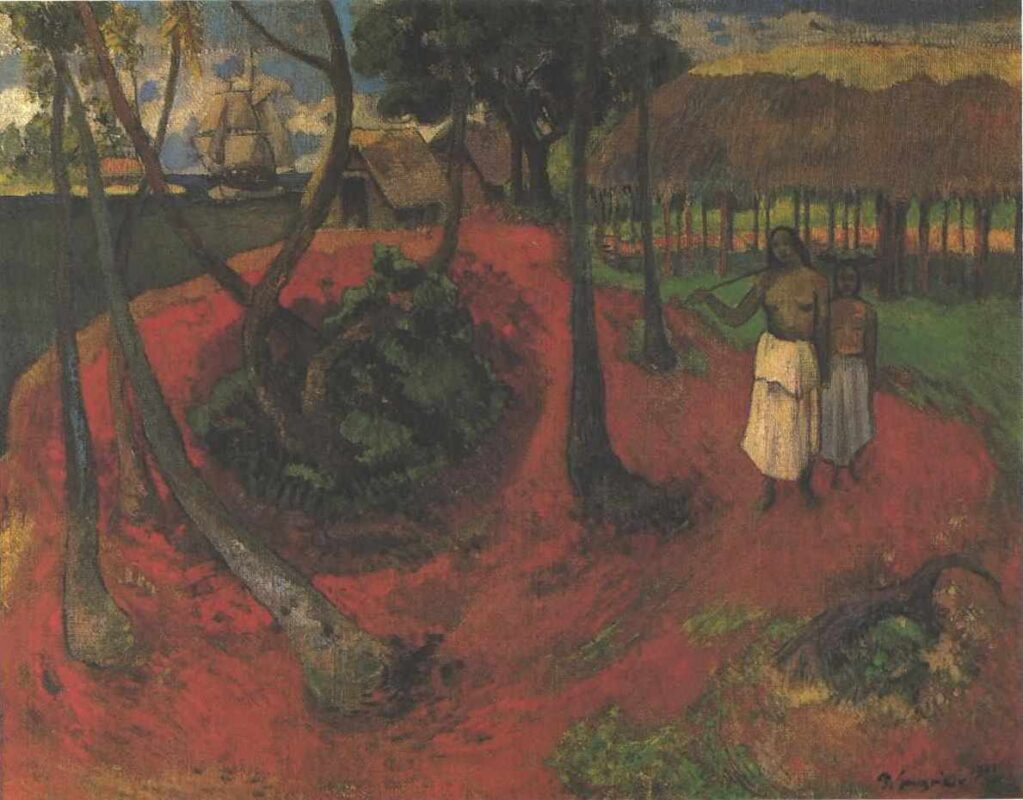
The female figure is still a fundamental part in his artistic oeuvre. In “Contes Barbares” (“exotic legends”, 1902, Essen, Folkwang Museum ), Gauguin once again praised Polynesian beauty, depicting two beautiful girls, sitting in an exotic landscape. Behind them, Gauguin represented the figure of his friend Meyer de Hann, a Parisian poet. It is quite curious that the figure of the western man is depicted as a demon with feline eyes and sharpening claws.
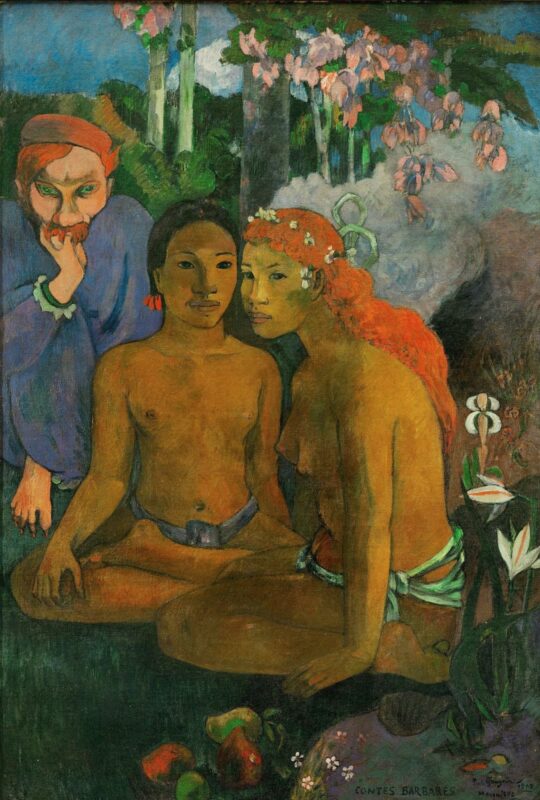
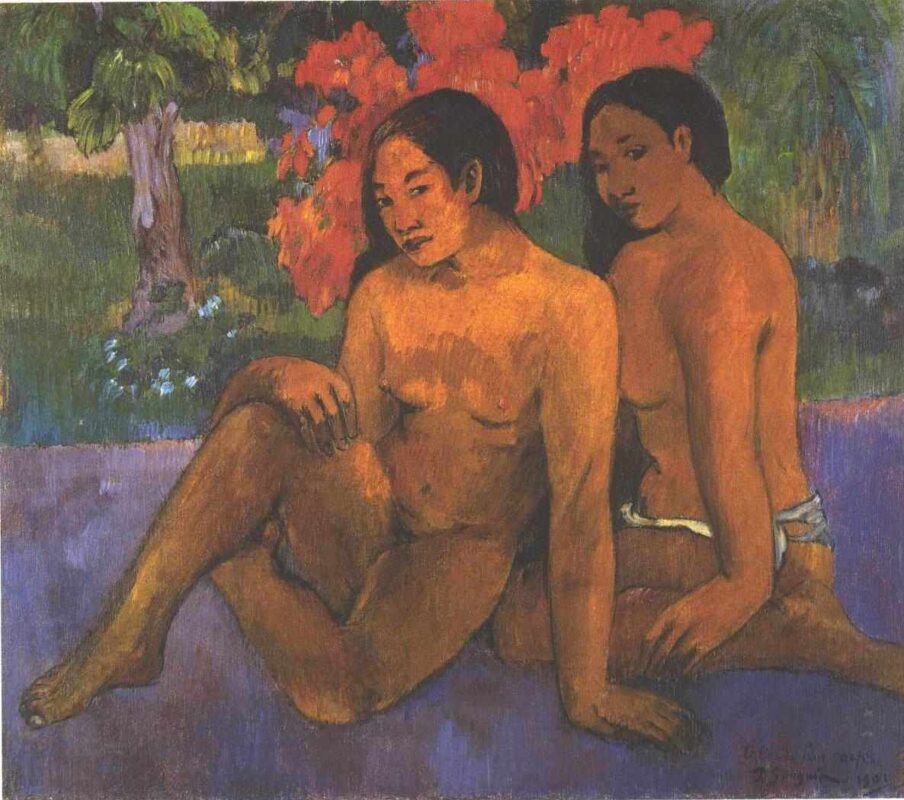
Nevertheless, Gauguin was at the time beginning to sense his own death: his physical deterioration was then unstoppable, and the artist was tempted -for the first time in many years- to return to Europe. However, he was still strong enough to paint. His compositions from these last years are full of metaphors ofdeath, as it is evident in his last masterwork, the two versions of “Riders on the beach” (Essen, Folkwang Museum, and Niarchos collection). In this kind of tribute to Degas racetrack pictures, Gauguin represented the riders in an apparently endless beach. The whole picture is filled with the melancholic taste of a farewell, as predicting the artist’s own death a few months later: the riders are quietly approaching to the seaside, where a breaker wave marks the limit between land and sea -or between life and death- from where two mysterious, colour-dressed spirits have appeared, perhaps to accompany the spirits in their last trip. The fancy coloured work is Gauguin’s pictorial testament and an eloquent ode to the Polynesian way of life.
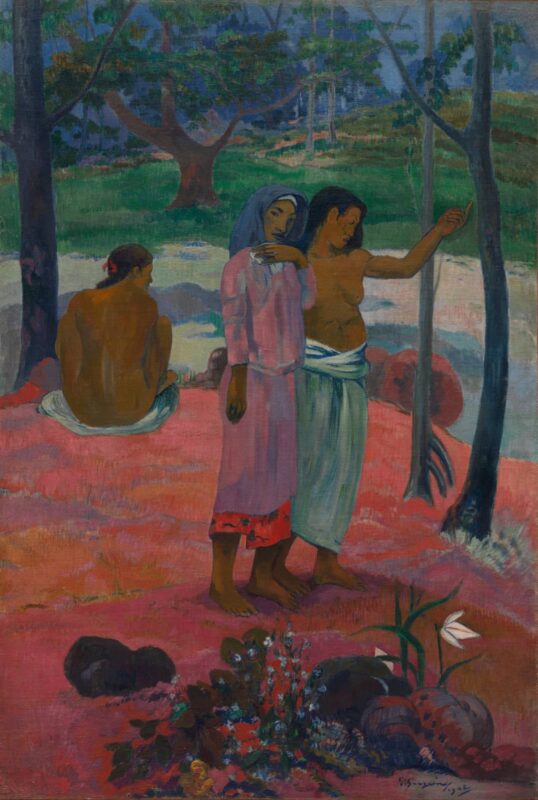
On May 8th, 1903, in the middle of multiple physical, economical and juridical problems, Gauguin died. The legend, not always veridical, tells that the natives, informed of the artist’s death, began to shout: “Gauguin is dead! There is no paradise!”
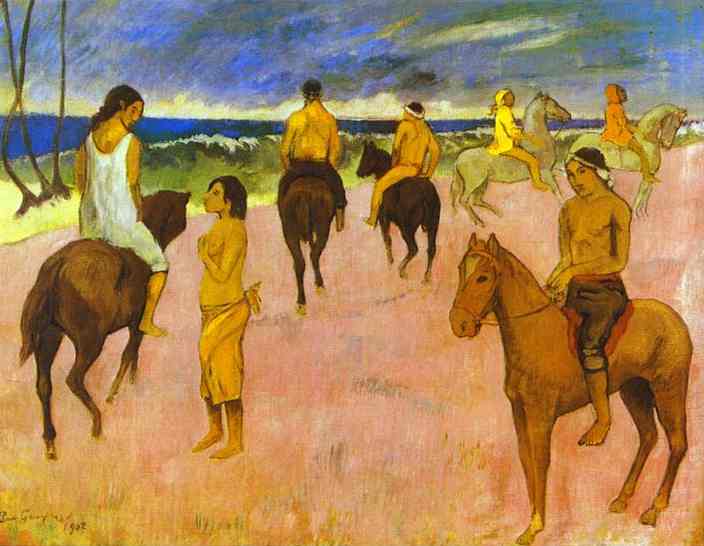
Follow us on:

